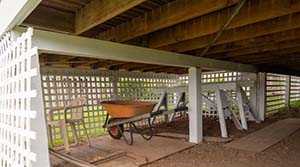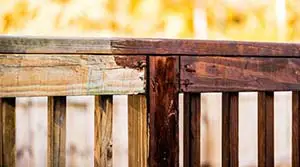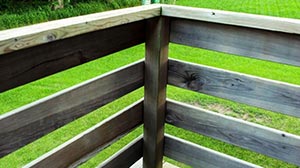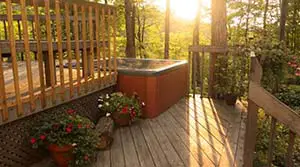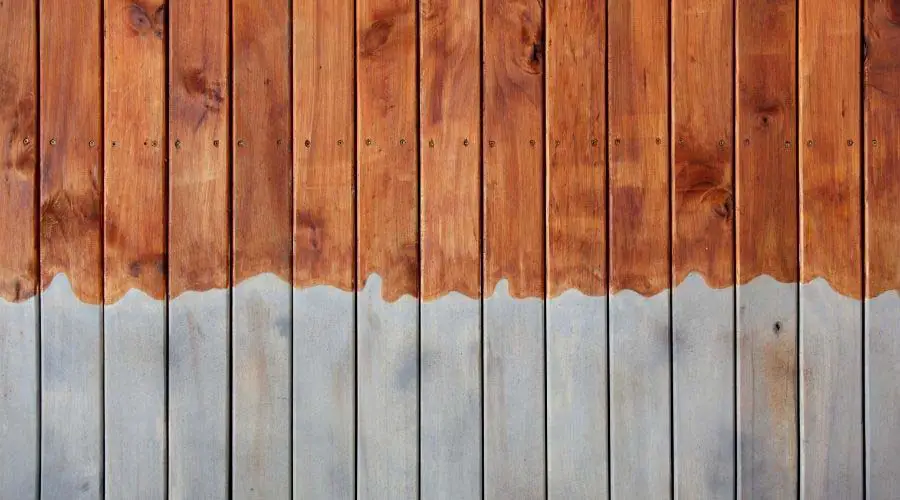
If you want to restore the aged appearance of your deck or preserve the elements of your new deck, staining is the way to go.
Once you have stained your deck, it is advisable to give it time to dry before using it again. So, how long should the deck stain dry before using it?
On average, a deck stain should take between 24 and 48 hours to dry. However, many factors come into play when influencing the drying period of the dye. These aspects are the brand of the paint, environmental matters, and the age of the wood.
While different circumstances can lead to other outcomes, this article will help you get the things you need to know to dry your stains—or whatever the situation is successful.
How Long Should Deck Stain Dry Before Use?
Coats of stain applied on a deck and how the color is used also determine how long the paint would dry.
Drying Times for Stain Types
1. Water-Based Deck Stain
Water-based deck stain has the fastest drying period. If you apply your paint when the weather is above 60 degrees, then expect to be dry within four hours.
However, you will need to wait for 24 hours before you can bring in your furniture. Nevertheless, you can start walking on it. Water-based stains are best for covered decks or interior applications.
2. Oil-Based Deck Stain
Oil-based deck stain is more accessible to apply but takes longer to dry than water-based deck stain. If you use an oil-based deck stain at temperatures above 60 degrees, you should expect it to dry within 24 hours.
Also, in case it rains before your deck stain is dry, you do not have to worry, as the oil-based stain can take up to 12 hours before the rain washes off the paint.
When applying oil-based, always use as directed. Avoid over-applying or under-stain applying for best results.
Oil-based stains provide better weather protection than water-based stains because the stain penetrates deeper into the wood, making it ideal for exterior exposure.
Factors Influencing the Drying Time of Stain
1. Type of Stain
Some types of stain dry faster, allowing you to use your deck within a short time, while others take much longer. Water-based paints, though hard to apply, take a short time. On the other side, though easy to use, oil-based stains take a long time to dry.
2. Wood Age & Type
New wood does not absorb stain easily and can take very long to dry. However, a block of old wood is very porous and, hence, has good paint absorption.
Also, the type contributes to deck drying time. Dense exotic hardwoods like IPE take very long to dry compared to pine.
3. The Number of Coats Applied
The number of stain coats you apply on a deck increases the drying time. Applying one dense coat instead of thin and many coats, the thicker the overcoat is, the more time it will take to dry.
4. Outdoor Temperature
When you buy a stain, someone should inform you of the right temperature to apply the paint. The temperature varies with the stain brand and ranges from 50 degrees to 90 degrees.
Though the temperatures between this range are favorable for applying the stain, the drying time will vary with temperature.
Deck stain will take a short time to dry when it is hot and take longer to dry when it is colder. The temperature staining ranges are crucial, and you must be very observant of them.
For example, if the stain temperature range is between 50 to 90 degrees, applying stain with temperatures below 50 degrees will leave a sticky material on the deck, which must be removed and redone.
Also, it will lead to a stain that never completely dries. Applying dyes when temperatures are above 90 degrees is not advisable.
The high temperatures can flash dry the stain leading to uneven application or blotchiness in appearance, which is not something you want.
5. Humidity
Humidity is the amount of moisture present in the air. On the other side, deck stain dries by evaporating the water into the air. Hence, if humidity is high, this will increase the drying time of the deck stain.
How Long Does Deck Stain Need to Dry Before Sealing?
How long a deck stain needs to dry before applying a seal depends on the type of stain and weather and the nature of the deck.
If you have just stained your deck, you need to give it 24 to 48 hours to dry before you can seal it. But this, of course, can be influenced by other external factors that can drag the stain’s drying period.
Despite the weather or the type of stain, all you need to do before sealing your deck after staining is to check if it is dry.
Deck staining strengthens the wood and protects your wood against pest intrusion. However, it is not enough to stain your deck.
After staining, you also need to seal your deck to protect it against splitting further, cracking, moisture, rotting, and mildew. You’ll find yourself with a uniformly tinted and colored deck that is free of splitting, splintering, and rotting.
You can check if the deck stain is dry by:
- Pouring some little water on the deck: If the deck stain absorbs the water immediately, then the deck is ready for sealing. However, if the water beads up, then you need to be a little bit patient.
- Using a moisture meter: A moisture meter would give you the exact moisture in the deck stain. If the moisture content is below 15%, then you can go ahead and seal it.
Dos & Don’ts of Sealing a Deck
1. Always Give a New Deck 30 Days Before Sealing
After installing your new deck, please wait for 30 days before sealing it.
If it is an old deck that you have just stained, give it 24- 48 hours before sealing it. However, before you begin filling, test the moisture content to be sure.
2. Choose Your Sealant Carefully
Most people confuse sealant, paint, and stain. You can apply it all on the deck at different times. Hence, knowing their difference and purpose on deck stain is essential to get the color you want.
Sealants have a water-repellant property and a thick viscosity, and hence their primary purpose is to protect the deck against moisture damage.
Stains include pigmentation, whose primary purpose is to give color to your deck and protect it against UV light. Some stains do offer moisture protection.
Paint can be either latex or oil-based. You can apply paint to a deck to protect against UV and moisture damage. Generally speaking, you won’t need to seal a deck you paint. However, compared to a sealant, the paint wears out faster.
Even if you had just stained your deck, the deck accumulated some dirt within the period you allowed it to dry. Hence, it is essential to clean and clean the deck after scrubbing and cleaning the stained deck and sanding it. Sanding would ensure a clean and bare surface fit for sealing.
4. Avoid Sealing Damp or Frosty Stained Wood
Sealing damp or frosty deck stains will give you an uneven and blotchy seal that can’t meet your goals. Again, the sealant is likely to bead up on the deck and fail to absorb, causing a messy and dangerous surface where one can slip.
5. Use Proper Techniques and Tools
When it comes to sealing a deck, you can do it yourself! But do you have the right tools and techniques to carry out the task?
You can apply a deck seal using a roller, a paintbrush, and a paint sprayer—the tools to use depending on how conversant you are in using them.
With these tools, you can work from one position with a pole or on your hands and needs. Be keen to ensure you seal every point of the deck appropriately.
A thick seal may peel or chip, while a thin seal would not give you your desired results. Hence, avoid oversaturating the sealant or under saturating the adhesive for the best result.
6. Check Your Local Weather Forecast
Know when the weather will be favorable to sealing. An ideal day for sealing your deck would not be very windy, and the temperatures range between 50 and 90 degrees.
Also, begin working in the morning as hot sun primarily experienced in the afternoon during summer is not favorable for staining. The hot sun can lead to quick evaporation of the sealant, preventing absorption in the deck stain.
7. Apply Deck Sealant Annually
Regardless of where you live, done right, you’ll only need to seal your deck once per year to protect it from UV rays and moisture.
What if it Rains Before Deck Stain Dries?
Rain can ruin a freshly stained deck if it hasn’t had enough time to dry.
Deck stain, when applied, is absorbed into the wood’s pores, becoming part of the top layers of the wood. If it rains before the deck stain dries, the rain can ruin it, interfering with the deck staining process.
However, if it rains before the stain completely dries, for example, 48 hours after you apply the paint, wood will absorb the rain in the wood faster than the stain, interfering with the stain’s absorption. In this case, you will get a splotchy surface instead of a fine texture.
If it rains immediately after applying the deck stain, it will peel and flake off. However, if the deck stain has been drying for close to 48 hours, peeling and flaking off may not happen.
What Should I Do to Avoid Rain Ruining My Deck Stain?
You will need to check the ideal weather for staining your deck is dry and cool, allowing the stain to penetrate the wood. Check your local weather to know when you can likely apply your paint.
What Happens if You Stain a Wet Deck?
The moisture in the wood will prevent the deck from absorbing the stain. We recommend waiting for at least 24 to 48 hours before you think of staining the deck. Ideally, wood moisture content should be 14% or less.
Otherwise, if you stain a wet deck, you risk having uneven results. A lack of adhesion in the wood will result in a thin final coat that will easily wash off.
Sometimes, you may have no choice but to stain your deck as it is. If the upcoming weather conditions are conflicting and all you have is to stain the deck, go ahead. The results will not be as appealing as a dry deck, but you will have given your wood some protection.
Cost of Staining & Sealing a Deck?
The average cost of staining a deck ranges between $551 and $1277. It will cost you approximately $2.75 to $10 per square foot for labor and materials. However, this price can differ depending on where you live.
Factors that Determine Deck Stain & Sealant Costs
1. Labor
The labor of sealing your deck will range between $0.50 to $3 per square foot. If you get a professional to do the job or have multiple levels, spindles, and stairs, the price can go up. In this case, the labor will cost you $2.5 and $7 per square foot.
2. Deck Sealant
An average project requires about two gallons of sealant that can cost approximately $50 to $80. The price depends on the viscosity of the adhesive. The thinner the glue, the less costly it is.
Here are some varieties of sealant brands and their prices:
- Total Wood Protection. It costs approximately $30 to $60 per gallon. This brand comes with a full line of stains, sealers, strippers, brightness, and cleaners.
- Behr. It costs approximately $35- $45. This brand comes with deck sealant, cleaners and finishes, and strippers.
- Sherwin-Williams. The deck stain costs $20 to $50 per gallon. You only need one coat of this sealant for long-lasting results.
- Olympics. This stain will cost you about $15 to $45 per gallon. The deck sealant offers stains, resurfaces, and cleaners.
3. Deck Sealing & Staining
You will find out your deck needs both sealing and staining in some instances. Though you cannot apply both simultaneously, you have to give staining time to dry before applying a sealant.
Applying sealant and staining would cost you about $700 to $1000 (The labor and materials).
4. DIY Deck Sealant
The sealers will cost approximately between $20 to $60 a gallon. Again, sealants would need many coatings. Hence you will require more than two gallons for some projects.
If your deck is medium-sized, a gallon will be enough for you. One gallon of a sealer can cover 200 to 300 square feet.
5. Deck Finishing
A deck finishing would cost you $600 to $1400. The finishing involves cleaning, sanding, and improving the deck’s look. You can cut costs by practicing the following:
- Power and pressure washing deck: This can cost you between $250 and $400.
- Sandblasting: this will cost you approximately $2 per square foot per hour.
Whether you use power and pressure washing or sandblasting, eventually, the deck stain will be clean and adequate for sealing. Hence you do not have to use both methods but one.
6. Size of the Deck
The bigger the size of the deck, the more you are likely to spend per square meter. Also, other features, such as stairs, labor, and materials, would increase the overall cost.
7. Condition of Your Deck
If your deck needs a lot of cleaning, you are likely to spend more money on cleaning labor than when you have kept it clean.
In addition, if the deck needs a lot of repairs, it will cost you more on repairing materials and labor.
Conclusion
In conclusion, sealing a deck is easy and affordable. You can choose to do it on your own or seek a professional. Before you begin sealing your deck, make sure it is clean and dry. Sealing a wet deck risks your chances of redoing it all over again or bearing with an uneven patio.
Also, remember to be careful when choosing your sealant for desired results. Sealing your deck will ensure it stays for long and maintains its natural color.
Sources

